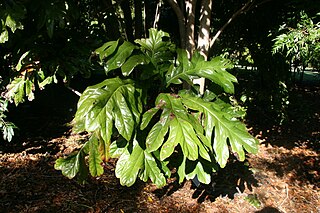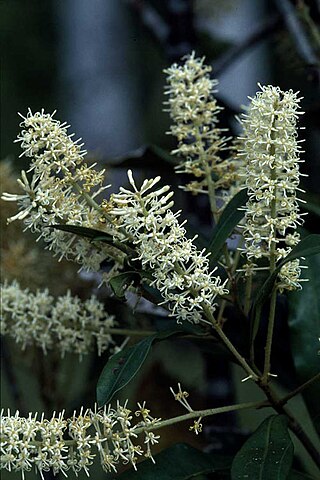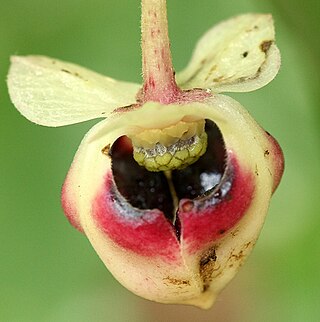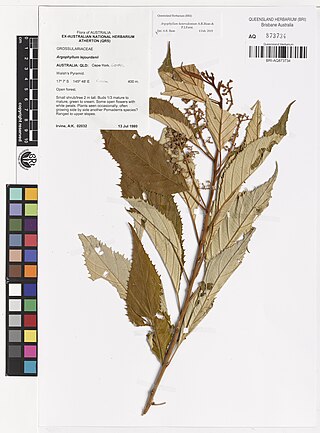
Athertonia is a monotypic genus of plants in the family Proteaceae. The sole described species is Athertonia diversifolia, commonly known as Atherton oak, athertonia, creamy silky oak or white oak. It is endemic to a small part of the Wet Tropics of Queensland, Australia. A relative of the macadamia, it has potential in horticulture and the bushfood industry.

Nothorites is a monotypic genus in the macadamia family Proteaceae. The sole species, Nothorites megacarpus, is endemic to the wet tropics rain forests of northeastern Queensland, Australia.

Mischarytera is a genus of rainforest trees, constituting part of the plant family Sapindaceae. Four species are known to science as of December 2013, found growing naturally in eastern Queensland, Australia, and in New Guinea. Formerly until 1995, they had names within the genus Arytera, subgenus Mischarytera.

Gardenia actinocarpa is a rare and endangered plant in the coffee and gardenia family Rubiaceae, native to a very restricted area within the Wet Tropics rainforest of northeastern Queensland.

Baileyoxylon is a monotypic genus in the family Achariaceae. The sole described species is Baileyoxylon lanceolatum which is restricted to a very small part of the Wet Tropics of Queensland. It was described in the mid 20th century.

Pseuduvaria mulgraveana is a species of plant in the family Annonaceae endemic to Queensland, Australia. L.W. Jessup, the botanist who first formally described the species, named it after the Mulgrave River, where the specimen he examined was collected.

Argophyllum curtum is a plant in the Argophyllaceae family endemic to a small part of north eastern Queensland. It was described and named in 2018.

Argophyllum palumense is a plant in the Argophyllaceae family endemic to a small part of north eastern Queensland. It was described and named in 2018.
Argophyllum ferrugineum is a plant in the Argophyllaceae family endemic to a small part of north eastern Queensland. It was described and named in 2018.

Argophyllum heterodontum is a plant in the Argophyllaceae family endemic to a small part of north eastern Queensland. It has an affinity to A. lejourdanii and was described and named in 2018.
Argophyllum iridescens is a plant in the Argophyllaceae family endemic to a small part of north eastern Queensland. It was described and named in 2018.

Acalypha lyonsii, commonly known as Lyon's acalypha is a shrub in the spurge family Euphorbiaceae that is only found in the vicinity of Cairns, Queensland, Australia.

Argophyllum cryptophlebum is a plant in the Argophyllaceae family of the order Asterales, which is endemic to a small part of north eastern Queensland. It was described and named in 1907.

Diploglottis bernieana, commonly known as Bernie's tamarind or large leaf tamarind, is a plant in the maple and lychee family Sapindaceae. It was first described in 1987 by the Australian botanist Sally T. Reynolds and is found only the Wet Tropics region of northeastern Queensland, Australia.

Peperomia bellendenkerensis is a plant in the pepper family Piperaceae found only in the Wet Tropics bioregion of Queensland, Australia.

Peperomia enervis is a plant in the pepper family Piperaceae found only in rainforests of northeast Queensland near the cities of Cairns and Mackay. It was first described in 1891.

Lepiderema sericolignis, commonly known as silkwood, is a plant in the maple and lychee family Sapindaceae found only in the Wet Tropics bioregion of Queensland, Australia.

Diploglottis smithii, commonly known as Smith's tamarind or wild tamarind, is a plant in the maple family Sapindaceae found only in the Wet Tropics bioregion of Queensland, Australia.
Thismia hawkesii, commonly known as fairy lantern, is a plant in the family Burmanniaceae found only in the Wet Tropics bioregion of Queensland, Australia.
Thismia lanternata, commonly known as fairy lantern, is a plant in the family Burmanniaceae found only in the Wet Tropics bioregion of Queensland, Australia.



















